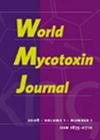Review of good agricultural practices for smallholder maize farmers to minimise aflatoxin contamination
IF 1.7
4区 医学
Q3 FOOD SCIENCE & TECHNOLOGY
引用次数: 12
Abstract
Maize is consumed world-wide as staple food, livestock feed, and industrial raw material. However, it is susceptible to fungal attack and at risk of aflatoxin contamination under certain conditions. Such contamination is a serious threat to human and animal health. Ensuring that the maize used by food industry meets standards for aflatoxin levels requires significant investment across the supply chain. Good Agricultural Practices (GAP) form a critical part of a broader, integrated strategy for reduction of aflatoxin contamination. We reviewed and summarised the GAP of maize that would be effective and practicable for aflatoxin control within high-risk regions for smallholder farmers. The suggested practicable GAP for smallholder farmers were: use of drought-tolerant varieties; timely harvesting before physiological maturity; sorting to remove damaged ears and those having poor husk covering; drying properly to 13% moisture content; storage in suitable conditions to keep the crop clean and under condition with minimally proper aeration, or ideally under hermetic conditions. This information is intended to provide guidance for maize growers that will help reduce aflatoxin in high-risk regions, with a specific focus on smallholder farmers. Following the proposed guidelines would contribute to the reduction of aflatoxin contamination during pre-harvest, harvest, and post-harvest stages of the maize value chain.审查玉米小农的良好农业规范,以尽量减少黄曲霉毒素污染
玉米作为主食、牲畜饲料和工业原料在世界范围内被消费。然而,它容易受到真菌的攻击,在某些条件下有黄曲霉毒素污染的危险。这种污染对人类和动物健康构成严重威胁。确保食品工业使用的玉米符合黄曲霉毒素水平标准,需要在整个供应链上进行大量投资。良好农业规范(GAP)是减少黄曲霉毒素污染的更广泛的综合战略的重要组成部分。本文综述了在黄曲霉毒素高风险地区对小农有效可行的玉米GAP。建议对小农可行的GAP是:使用耐旱品种;生理成熟前及时采收;分拣拣去受损的耳和外壳覆盖度差的耳;适当干燥至13%水分含量;储存在适当的条件下,以保持作物清洁,并在最低限度的适当通风条件下,或理想的密封条件下。这些信息旨在为玉米种植者提供指导,以帮助在高风险地区减少黄曲霉毒素,并特别关注小农。遵循拟议的指导方针将有助于减少玉米价值链的收获前、收获和收获后阶段的黄曲霉毒素污染。
本文章由计算机程序翻译,如有差异,请以英文原文为准。
求助全文
约1分钟内获得全文
求助全文
来源期刊

World Mycotoxin Journal
MYCOLOGY-
CiteScore
4.60
自引率
5.00%
发文量
25
审稿时长
>12 weeks
期刊介绍:
''World Mycotoxin Journal'' is a peer-reviewed scientific journal with only one specific area of focus: the promotion of the science of mycotoxins. The journal contains original research papers and critical reviews in all areas dealing with mycotoxins, together with opinions, a calendar of forthcoming mycotoxin-related events and book reviews. The journal takes a multidisciplinary approach, and it focuses on a broad spectrum of issues, including toxicology, risk assessment, worldwide occurrence, modelling and prediction of toxin formation, genomics, molecular biology for control of mycotoxigenic fungi, pre-and post-harvest prevention and control, sampling, analytical methodology and quality assurance, food technology, economics and regulatory issues. ''World Mycotoxin Journal'' is intended to serve the needs of researchers and professionals from the scientific community and industry, as well as of policy makers and regulators.
 求助内容:
求助内容: 应助结果提醒方式:
应助结果提醒方式:


